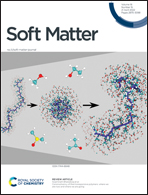A new aggregation induced emission enhancement (AIEE) dye which self-assembles to panchromatic fluorescent flowers and has application in sensing dichromate ions†
Abstract
We report for the very first time the crystal structure and self-assembly of a new aggregation-induced emission enhancement (AIEE) dye 4-(5-methoxythiazolo[4,5-b]pyridin-2-yl)-N,N-dimethylaniline (TPA) and its application in sensing dichromate ions. TPA reveals cyan blue emission under UV and visible light. The self-assembly properties of TPA were studied extensively by scanning electron microscopy (SEM) which revealed the formation of beautiful flower-like morphologies. These structures revealed both green and red fluorescence under FITC and rhodamine filters respectively when observed through fluorescence microscopy connoting the panchromatic emission properties of TPA from blue to red. The interactions which cause self-assembled structure formation in TPA were also validated theoretically using density functional theory (DFT) calculations. Crystal and molecular structure analysis of TPA was carried out via single-crystal X-ray diffraction to visualize the intermolecular interactions occurring in the solid-state and to study the structure-photophysical property relationship in the aggregated state. The photophysical properties of TPA were also studied extensively by UV-visible and fluorescence spectroscopy and its quantum yield and fluorescence lifetime were calculated by time-correlated single-photon counting (TCSPC). Interestingly, TPA could efficiently sense dichromate (Cr2O72−) ions in an acidic medium and an interesting morphological transition from a fluorescent flower to non-fluorescent disassembled structures could also be observed. The limit of detection of TPA for Cr2O72− ions was found to be as low as 5.5 nM, suggesting its exceptional sensitivity. More importantly, TPA could selectively sense Cr2O72− ions in real water samples even in the presence of other metal ions routinely present in polluted water, hence making it practically useful for water quality monitoring.



 Please wait while we load your content...
Please wait while we load your content...